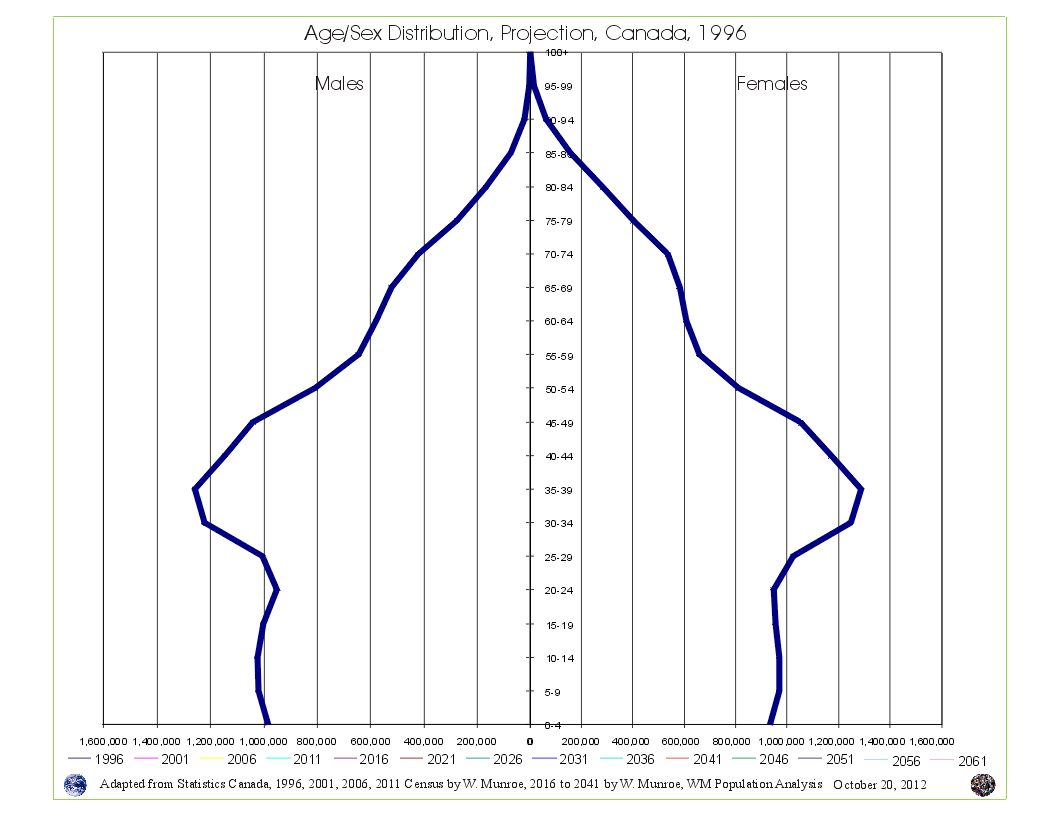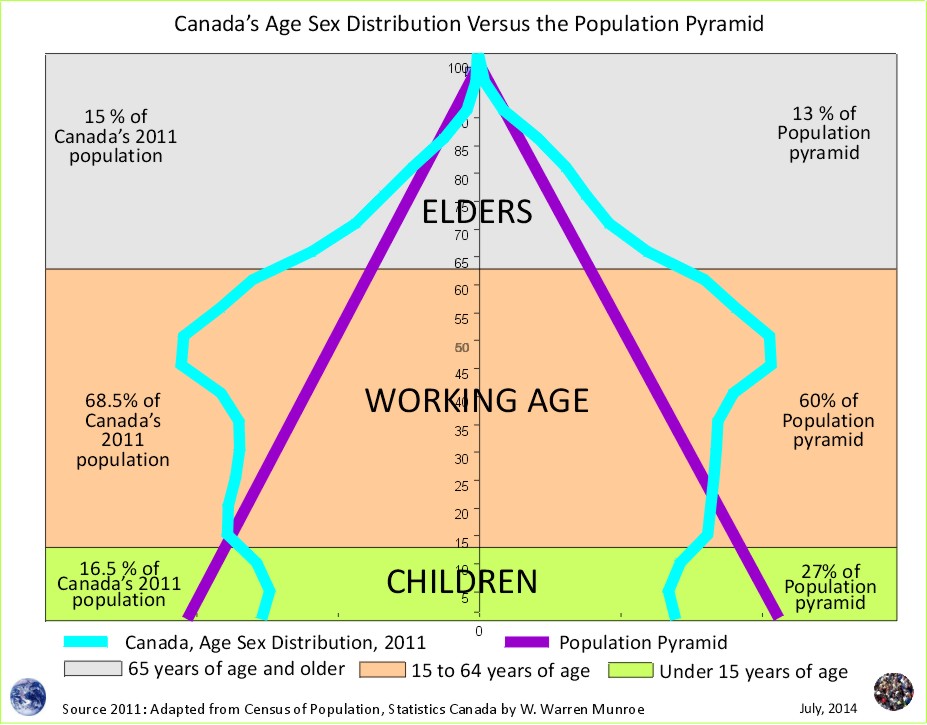
We live in the last half of the one hundred year revolution (roughly the extent of most human's potential longevity) shaped by the transition from above to below replacement fertility.
What impacts will there be? Let's take a look at a chart of the recent changes (from one census to the next) in Canada's broad age groups with the addition of a medium scenario population projection.
As expected, the change from one census to the next in the number of elders, people 65 years of age and over (the grey line), will continue to rise (at least until 2026 or so) while the change in the number of people of working age, (in this example we use the number of people 15 to 64 years of age inclusive) will continue to decline, becoming marginally negative in the mid 2020s to the early 2030s. Over the next 30 years or so, the change in the number of children (0 to 14 years of age) will likely continue to rise and fall meeting up with the change in the number of elders by the end of this medium scenario projection.
The decline in the change in the number of people of working age results from the increase in the number of people aging into retirement. The decline in the change in the number of elders after 2026 is a result of the baby boomers, born shortly after WWII between 1946 and 1951, aging into the high mortality years of 80 years of age and over.
The fluctuating / oscillating change in the number of children is a result of the fluctuating / oscillating change in the number of people of reproductive age - a reverberation coursing through our society resulting from the transition from above to below replacement fertility beginning in the late 1960s early 70s.
The last half of the 100 year revolution will likely provide the largest impacts in terms of the change in the broad age groups.
What do you think?
1 The figures for 1996, 2001, 2006, and 2011 are adapted from Statistics Canada, 1996, 2001, 2006, and 2011 Census of Population counts, by William Warren Munroe. The 2016 to 2041 projection numbers by William Warren Munroe are created using the cohort change ratios method based on the 1996, 2001, 2006, and 2011 Census of Population counts from Statistics Canada's website
The figures for 2016 to 2041 are developed by William Warren Munroe using the cohort change ratios method based on the 1996, 2001, 2006, and 2011 Census of Population counts.
Statistics Canada. 2012. Population and dwelling counts, for Canada, provinces and territories, 2011 and 2006 censuses (table). Population and Dwelling Count Highlight Tables. 2011 Census. Statistics Canada Catalogue no. 98-310-XWE2011002. Released February 8, 2012. http://www12.statcan.ca/census-recensement/2011/dp-pd/hlt-fst/pd-pl/File.cfm?T=101&SR=1&RPP=25&PR=0&CMA=0&S=50&O=A&LANG=Eng&OFT=CSV (accessed February 08, 2012). For further information, refer to: http://www12.statcan.gc.ca/census-recensement/2011/dp-pd/hlt-fst/pd-pl/Notes-eng.cfm.
Population Projection Project for Canada's Census Areas
 Take a look at Canada's Age Sex Distribution animated projection (medium scenario). The animation starts at 1996 and clicks through to 2041. Notice in the 1996 chart, the baby boom bulge (which is just the resumption of more births than deaths - the population pyramid - after WW2) followed by fewer numbers in the younger age groups reflecting (resulting from) reduced fertility beginning in the mid 1960s. This medium scenario projection is an average of the 1996 to 2011 cohort change ratios thus creating a central tendency that eventually provides smooth lines in the younger age groups by the end of the projection period.
Take a look at Canada's Age Sex Distribution animated projection (medium scenario). The animation starts at 1996 and clicks through to 2041. Notice in the 1996 chart, the baby boom bulge (which is just the resumption of more births than deaths - the population pyramid - after WW2) followed by fewer numbers in the younger age groups reflecting (resulting from) reduced fertility beginning in the mid 1960s. This medium scenario projection is an average of the 1996 to 2011 cohort change ratios thus creating a central tendency that eventually provides smooth lines in the younger age groups by the end of the projection period.
Why are Statistics Canada's projections so high compared to the United Nations and the Cohort Change Ratios projections?
Government population projections for BC reflect an "up and to the right" aspiration, while the cohort change ratios method shows BC's population growth slowing, and levelling out. Read a "A Comparison of Population Projections for BC"...


